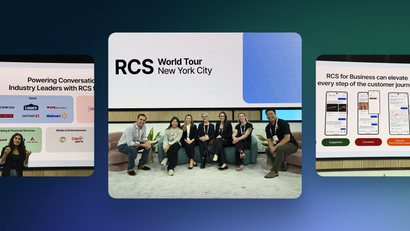SMS marketing continues to deliver exceptional returns for businesses across industries. For businesses looking to maximize their customer engagement and conversion rates, implementing an effective SMS marketing strategy is essential.
This guide will walk you through everything you need to know about SMS marketing platforms, how to calculate and improve your ROI, and the key features to look for when selecting the right solution for your business.
Understanding SMS marketing ROI in 2025
SMS marketing consistently outperforms other digital channels when it comes to return on investment. Recent studies show that businesses can expect ROI rates as high as $8.11 per message from their SMS marketing campaigns[1]. This impressive return stems from several factors unique to SMS:
What makes SMS marketing so effective
SMS boasts open rates of over 97%, with the majority of messages read within 15 minutes of receipt. This immediate engagement creates opportunities for time-sensitive offers and real-time customer interactions that other channels simply cannot match.
The direct nature of SMS creates a personal connection with customers. When a message arrives on a customer's most personal device, their smartphone, it creates an intimate touchpoint that feels more direct than email or social media.
Calculating your SMS marketing ROI
To accurately measure the effectiveness of your SMS campaigns, you need to track specific metrics and apply a simple formula:
- Track the revenue generated from your SMS campaign
- Calculate the total cost of the campaign (including platform fees, message costs, etc.)
- Apply the ROI formula: ROI = [(Revenue - Cost) / Cost] × 100%
For example, if your SMS campaign generates $3,000 in sales with a total cost of $500, your ROI calculation would be:
ROI = [($3,000 - $500) / $500] × 100% = 500%
This means for every $1 invested in your SMS marketing, you're receiving $6 in revenue, a 500% return on your investment.
Key features of an effective SMS marketing platform
When evaluating SMS marketing platforms, certain features are critical for maximizing your ROI potential:
Automation capabilities
Automation is the cornerstone of efficient SMS marketing. Look for platforms that offer:
- Triggered messages based on customer behavior
- Scheduled campaigns for optimal timing
- Automated workflows that integrate with other marketing channels
- Personalization options that dynamically insert customer data
Automation not only saves time but also ensures messages reach customers at the perfect moment, significantly increasing conversion rates.
Analytics and reporting
Without robust analytics, you're essentially marketing blindfolded. A comprehensive SMS platform should provide:
- Delivery and open rate tracking
- Click-through rate monitoring
- Conversion tracking
- A/B testing capabilities
- ROI calculation tools
These analytics allow you to refine your approach, identify what's working, and optimize underperforming campaigns.
Integration capabilities
Your SMS marketing doesn't exist in isolation. The best platforms integrate seamlessly with:
- CRM systems
- eCommerce platforms
- Email marketing tools
- Customer support software
- Analytics platforms
OneSignal's platform unifies multiple messaging channels including SMS, push notifications, email, and in-app messaging, creating a cohesive customer communication strategy rather than siloed approaches.
Building an SMS list that drives results
The foundation of successful SMS marketing is a quality subscriber list. Unlike email, where list size often takes precedence, SMS marketing thrives on engagement quality.
Compliance and best practices
SMS marketing is subject to strict regulations. Always ensure your SMS marketing adheres to:
- Explicit opt-in requirements
- Clear identification of your business
- Easy opt-out instructions
- Frequency expectations
- Privacy policy transparency
Violating these requirements can result in significant penalties and damage to your brand reputation.
Cost-effective list building strategies
Building your SMS subscriber list doesn't have to break the bank. With the right approach, you can acquire subscribers at a reasonable cost:
- Website opt-in forms
- Point-of-sale sign-ups
- Social media promotions
- Exclusive content offers
- Contest entries
By calculating your cost per subscriber, you can optimize your acquisition strategy. For example, if your campaign costs $250 and generates 5,000 subscribers, your cost per subscriber is just $0.05.
Crafting high-converting SMS campaigns
The content and structure of your SMS messages directly impact your conversion rates and ROI.
Message optimization techniques
To maximize engagement and conversions:
- Keep messages concise (under 160 characters when possible)
- Include a clear call-to-action
- Create a sense of urgency
- Personalize content based on customer data
- Test different message formats and timing
Segmentation strategies
Not all customers should receive the same messages. Effective segmentation includes:
- Purchase history-based segments
- Behavioral segments (active vs. inactive)
- Demographic segments
- Geographic segments
- Preference-based segments
Proper segmentation can significantly increase conversion rates by ensuring messages are relevant to each recipient.
Measuring and improving your SMS marketing performance
Continuous improvement is key to maintaining and increasing your SMS marketing ROI over time.
Beyond basic metrics
While delivery and open rates provide valuable insights, deeper metrics reveal the true impact of your SMS campaigns:
- Revenue per message
- Customer lifetime value impact
- Retention rate improvements
- Cross-selling success rates
- Churn reduction metrics
These advanced metrics help you understand not just how your campaigns perform in isolation, but how they contribute to overall business objectives.
Testing and optimization framework
Implement a structured approach to testing:
- Establish a baseline performance metric
- Test one variable at a time (timing, message length, offer type, etc.)
- Analyze results against your control group
- Implement winning variations
- Repeat the process continuously
This methodical approach ensures that your SMS marketing strategy evolves based on data rather than assumptions.
Integrating SMS with multi-channel marketing
SMS marketing reaches its full potential when integrated with other channels in a cohesive strategy.
Creating a unified customer experience
A multi-channel approach allows you to:
- Reinforce messages across different touchpoints
- Reach customers on their preferred channels
- Create consistent brand experiences
- Capture data from multiple sources
- Optimize marketing spend across channels
Platforms like OneSignal that unify multiple messaging channels (SMS, email, push notifications, and in-app messaging) through a single interface make this integration seamless and efficient.
Channel coordination strategies
Effective multi-channel coordination includes:
- Sequential messaging across channels
- Channel-specific content adaptation
- Cross-channel response tracking
- Unified customer profiles
- Consistent timing and messaging
Unlock the true power of SMS with OneSignal
Whether you're building your first SMS campaign or refining a cross-channel engagement strategy, OneSignal’s powerful SMS capabilities, automation tools, and unified platform help you drive measurable results and unlock the full ROI potential of mobile messaging.




